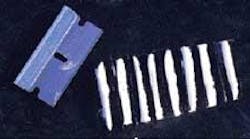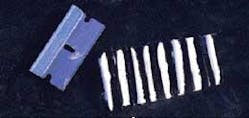by Michelle Klassen, RDH
Have you ever discovered abnormal tissues in the oral cavity but could not provide an accurate diagnosis? You had a sneaking suspicion that there was more to the dental disease then what was actually revealed to you by your patient. The dental professional should consider substance abuse as a cause for unusual signs and symptoms of dental disease.
This article discusses drugs causing dental disease when used by persons for non-medical purposes. The categories of drugs presented will be that of CNS depressants, CNS stimulants, and psychedelics.
The chronic abuse of the CNS depressants, ethyl alcohol/ethanol and the opioid analgesic, heroin, are known to cause dental disease. Ethyl alcohol, used socially as a sedative agent, has dental implications if used for an extended period of time. Chronic use increases risk of cancer of the mouth, pharynx, larynx, esophagus, and liver. The clinician may also discover enlarged salivary glands. Vitamin B deficiencies and an unhealthy, dirty oral cavity are usually seen with those abusing alcohol. It is very difficult to find clinical symptoms associated with isolated alcohol use because usually tobacco is used in conjunction with alcohol. Extraoral signs to watch for are breath and body odor of alcohol; hand, tongue and eyelid tremors; redness of the forehead, cheeks and nose; and jaundice of the face.
The opioid analgesic, heroin, has some surprising dental effects. These effects need to be seen to be believed! Heroin has very addictive properties due to its ability to elevate mood, slow respiration, relieve fear and apprehension, cause a feeling of peace and tranquility, suppress hunger, and decrease sexual drive. Be aware! Abusers tend to have a higher incidence of dental caries and periodontal disease due to neglect, than does the general population. Dental caries are seen on the labial and buccal cervical third of the teeth rather than on the occlusal or interproximal surfaces. These lesions are usually darker, larger and less painful than routine caries.
Another sign to watch for with heroin abuse is that of anorexia, which can be seen in those persons abusing heroin, cocaine, and amphetamines. The most surprising disease to be diagnosed in the oral cavity is termed allergic thrombocytopenia. This is caused by the quinine in adulterated heroin and may appear as ecchymosis (an irregular hemorrhagic area) of the oral mucous membranes. The ecchymosis is seen as a small hemorrhagic spot, larger than a petechia, in the skin or mucous membrane, forming a non-elevated, round or irregular, blue or purplish patch.
Quinine is an alkaloid of cinchona (a white microcrystalline powder). It has analgesic properties and is a cardiac depressant used for malaria. Cinchona is a genus of rubiaceous trees.
Effects of stimulants
The following CNS stimulants — amphetamines, caffeine, nicotine, cocaine, and speed — also promote dental disease with chronic use ... the effects of cocaine being the most alarming. A person abuses amphetamines to feel euphoria, increased energy and alertness, omnipotence, and self-confidence. Unfortunately, chronic use of amphetamines causes xerostomia and bruxism due to the anxiety, hallucinations, and paranoid fears the user may be experiencing. The clinician should consider amphetamine abuse if noticing dry mouth and wear facets on the occlusal surfaces of the patient's teeth, as well as unexplained recession which is also the result of bruxism.
People with chronic caffeine intake use caffeine as a stimulant. Those who use tobacco and alcohol usually consume caffeine as well. Patients who chronically drink coffee or tea may have an increase in dental stains, resulting in an increase in formation of plaque and calculus, leading to gingivitis and periodontal disease.
Nicotine is used as a stimulant that causes increased alertness, relaxation, better concentration and memory, and decreased appetite and irritability. There is an increase in dental stains causing a 50 percent increase in the formation of plaque, calculus and periodontal disease. There is also an increase in the incidence of oral cancer, halitosis, hairy tongue, and xerostomia. Squamous cell carcinoma can be a result of tobacco use, which is seen as a malignant tumor of squamous epithelium. Clinically, it is usually an exophytic, ulcerative mass. Early tumors may be red and plaque-like, white and plaque-like, or a mixture of red and white areas (speckled leukoplakia). Chronic iron deficiency has also been associated with this cancer. This may occur anywhere in the oral cavity. Clinicians should examine the entire oral cavity, but focus on the most common sites for tumors — the floor of the mouth, ventrolateral tongue and soft palate, tonsillar pillar and retromolar areas.
Smokeless tobacco causes serious changes in the oral mucosa such as chronic gingivitis, recession, leukoplakia, and precancerous lesions where snuff is held. Be aware ... that excessive chewing of nicotine gum can cause dislodging of dental restorations and can stick to dentures. Therefore, check all restorations carefully. Make your patients aware.
The effects of cocaine
Cocaine is of most interest to me as its effects are the most devastating to the oral cavity. A lack of knowledge regarding cocaine's effects in the oral cavity can leave the clinician feeling puzzled by unusual signs and symptoms of dental disease. Cocaine is an extremely addictive substance used as a stimulant by the abuser to achieve intense euphoria, self-confidence, decrease in hunger and, unfortunately, paranoia, extreme excitability and a deviated nasal septum.
There are two ways in which cocaine can be used, by smoking cocaine or by topical application. When crack cocaine is smoked, the clinician may notice necrotic lesions of the tongue and epiglottis as well as laryngeal burns. There is a significant difference in the size and appearance of the lesion formation on the palate when comparing an HIV positive patient versus an HIV negative patient. The HIV positive patient will reveal larger and/or multiple lesions when compared to an HIV negative patient. So, the diagnosis is much more exaggerated with an HIV positive patient. The cause of these lesions is most likely the extreme heat of the smoke. It is possible that the chemical content of the smoke also contributes to lesion development. The most common location of these lesions is found around the midline of the palate, a common location of contact by the heated smoke.
When someone intraorally applies cocaine hydrochloride, the patient may present with rapid gingival recession and dental erosion. This may be found in the area(s) of the oral cavity where the patient is rubbing cocaine directly on their gingival tissues. Patients may complain of very sore gingival tissues with rapidly receding gums. When examining the radiographs, the clinician may notice severe alveolar bone loss around the area of rapid recession and acute gingival attacks. The patient may have unsuccessful healing or attachment after a connective tissue graft is performed to cover the exposed root surfaces.
The oral manifestations of a patient who may be abusing cocaine are recession, chronic gingivitis and periodontitis, angular cheilitis, oral candidiasis, glossodynia, cervical abrasion, gingival laceration, reduced salivary secretions, increased dental caries, abnormal tooth wear patterns due to severe bruxism, and acute gingival inflammatory effects. If a patient combines the cocaine and alcohol addiction, we see the most severe oral disease. This presents as severe xerostomia, advanced periodontitis, many decayed and missing teeth, severe tooth attrition from bruxism, and TMJ disorders.
Speed and marijuana
I have observed the following findings in patients who are or were abusing speed. Speed is known to cause extreme erosion of enamel surfaces due to the high temperature that is required to smoke speed. In some instances, patients abuse more than one drug at a time. Therefore, the oral disease is more pronounced. Patients will display a yellowish-brown area in the receded areas with extreme sensitivity to instrumentation and cold air or water. There are usually many decayed, missing, and fractured teeth with poor oral hygiene. Further research is needed on the effects that speed has in the oral cavity.
Marijuana is another drug that I am currently researching in the private practice. I find that the dental disease caused by chronic abuse is more devastating than that of tobacco use. This may be due to the ability of marijuana to heat up to a higher temperature than tobacco due to the differing of chemical components. Marijuana is abused to achieve euphoria, enhanced sensory perception, sedation, altered consciousness, and a "dreamlike" state.
The dental implications for chronic use of marijuana are xerostomia, gingivitis, and various leukoplakias with hyperkeratosis and parakeratosis with pseudoepitheliomatous hyperplasia. Heavy smoking can lead to chronic bronchitis and precancerous changes in the bronchioles. Dental professionals must make users aware of these changes! A cue for the clinician is the color of stain, which is seen as a tenacious greenish brown stain. Always ask your patients if this stain is from tobacco use. You may be surprised when some patients admit they do not smoke cigarettes but do smoke marijuana. Marijuana users tend to have a greater incidence of decayed, missing and filled teeth and greater microbial plaque with resulting gingivitis.
Dental hygienists are in the most opportune position to discover if a patient is abusing a substance(s). They can make the patient aware of the dental disease caused by these substances and then provide the appropriate hygiene therapy to help treat and maintain the patient's existing dentition.
We can act as a positive role model for our patients abusing substances and most importantly to those youths who have not started abusing substances. It is not enough to help only those patients already addicted. We need to provide primary prevention to those who have not experimented with drugs by informing the patients why they should not start.
References available upon request. Michelle Klassen, RDH, has been involved with the oral health care profession since 1989 and resides in Edmonton, Alberta. She has a two-year diploma specializing in addiction studies from the University of Alberta, Faculty of Extension. Currently, Michelle is employed in private practice as a dental hygienist.






